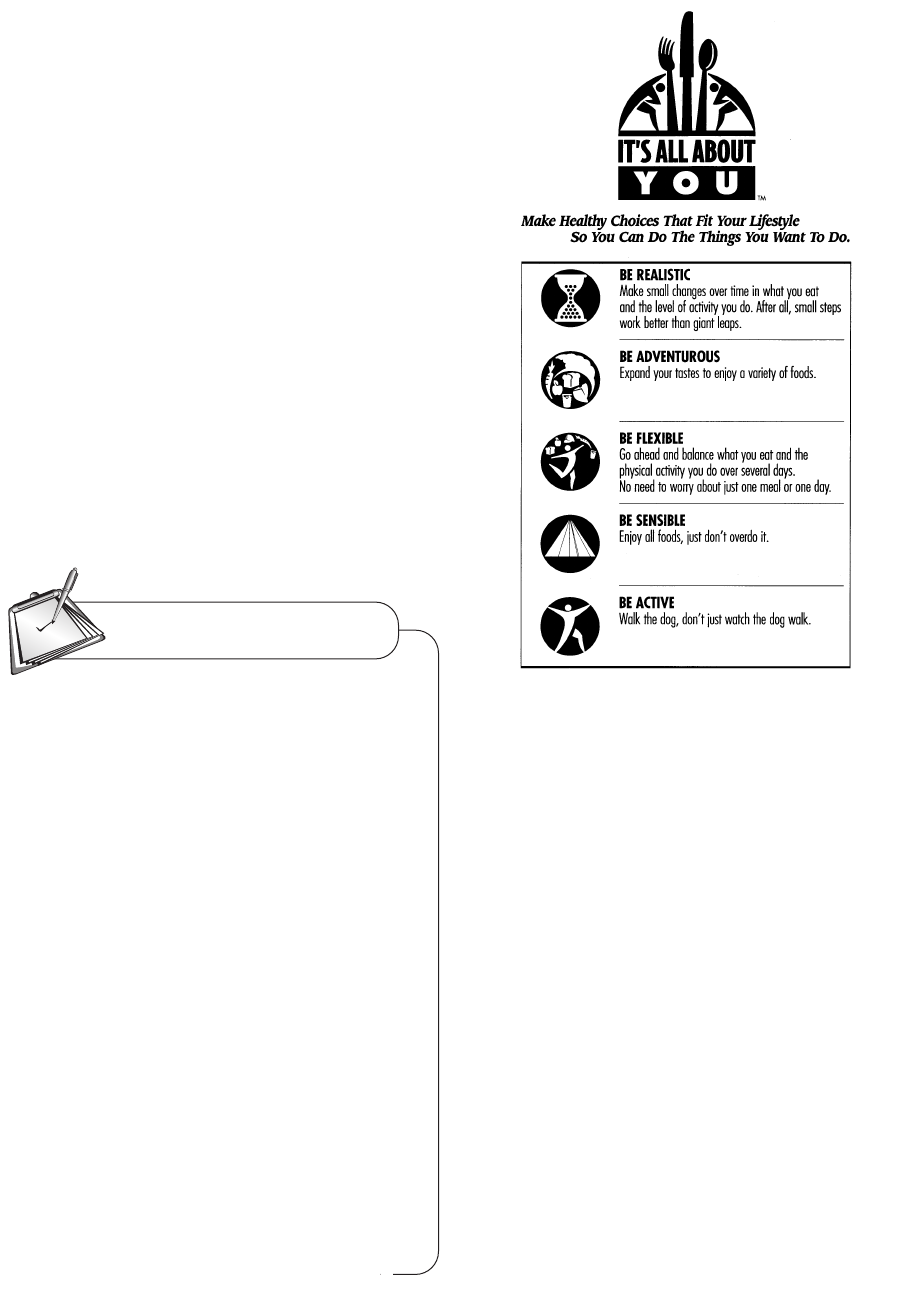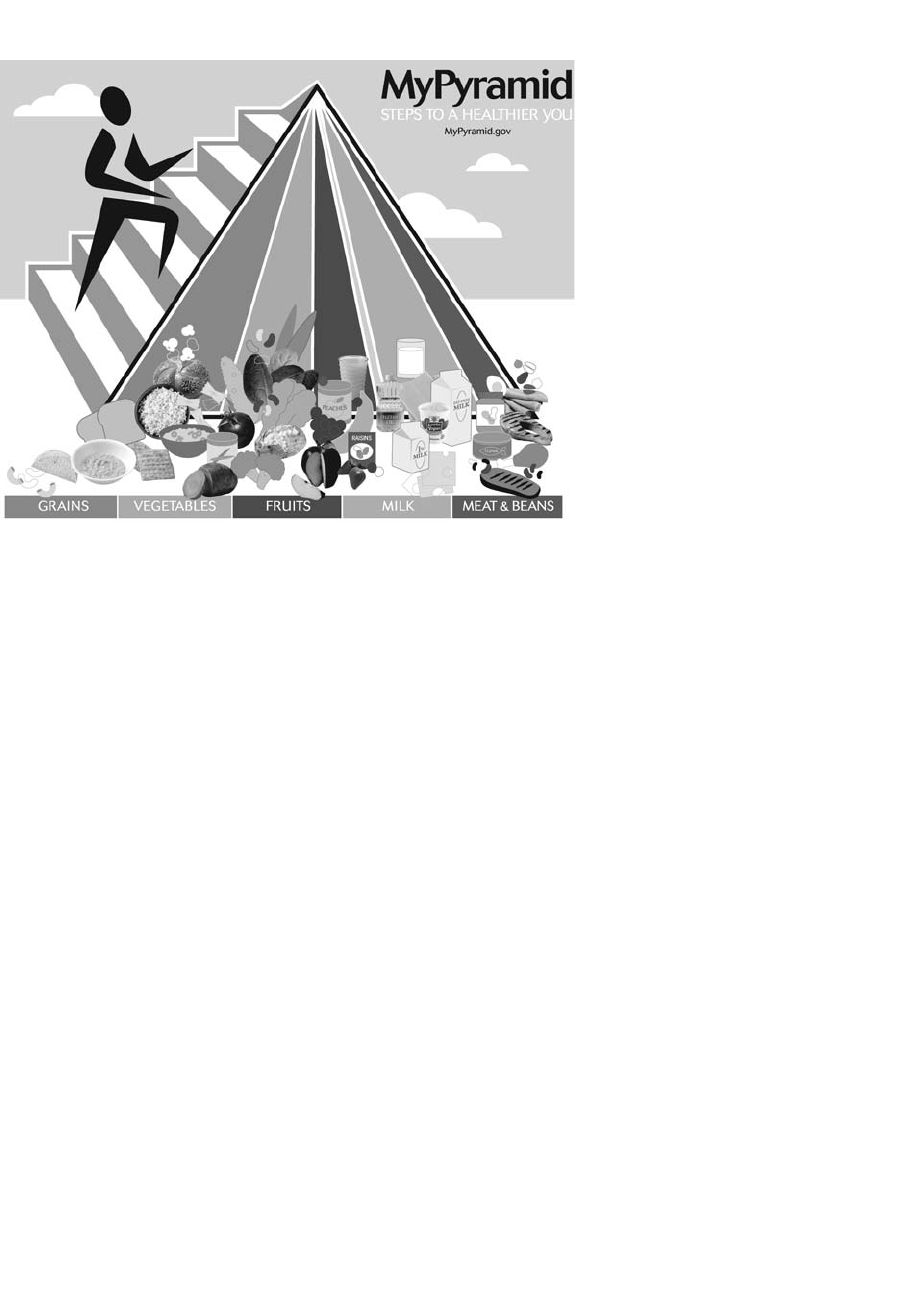
American Dietetic
Association
Complete Food and
Nutrition Guide
Roberta Larson Duyff
MS, RD, FADA, CFCS
John Wiley & Sons, Inc.
3 RD E DITION
ffirs.qxd 7/27/06 5:41 PM Page iii
ffirs.qxd 7/27/06 5:41 PM Page ii

Praise for the
American Dietetic Association Complete
Food and Nutrition Guide
“. . . jam-packed with practical eating and food safety tips.”
—USA Today
“This book will appeal to those who want to know a little bit about everything in
nutrition but don’t have a science background.”
—Chris Rosenbloom, PhD, RD, The Atlanta Journal-Constitution
“Of the five books closest to my keyboard, this guide is one of the most frequently
used. A dynamite resource!”
—Antonia Allegra, CCP, executive director, Symposium for Professional Food Writers;
food, wine, travel author
“Bottom line, this is the best consumer nutrition book out. It’s user-friendly, and it’s
complete. From a tidbit to a chapter, if it matters in nutrition, Roberta Duyff has
included it. This book is worth its weight in gold.”
—Keith Ayoob, EdD, RD, Associate Professor of Pediatrics,
Albert Einstein College of Medicine, New York City
“. . . this nutrition bible is a good bet. This reputable resource separates fads from
facts and answers questions from apples to zucchini, allergies to vegetarian diets.”
—Nancy Clark, MS, RD, Running Network and Sweat magazine
“. . . turns a complicated subject into everyday practical information . . . a fun read.”
—Claire Lewis, Today’s Health and Wellness magazine
“Sorting out the constantly changing world of nutrition information, diets, and
weight loss fads can be tricky, but this book provides all the facts in an easy-to-
read format.”
—Connie Diekman, MEd, RD, Director of University Nutrition, Washington University
“[A] remarkable reference.”
—Graham Kerr, author, culinary expert, TV personality
ffirs.qxd 7/27/06 5:41 PM Page i

“. . . brimming with tips from baby food to eating for healthy aging.”
Shape magazine
“[The book] may be the ultimate healthy-eating primer. How often can it be said
of a book that it many extend your life?”
—Fitness magazine
“Duyff really covers nutrition and healthy eating from all angles . . . without over-
using the ‘d’ word [don’t].”
—Tufts University Health & Nutrition Letter
“. . . brings healthy eating and the family table together.”
—Chef Art Smith, author, Back to the Table: Reunion of Food and Family
“ . . . tackles most of the nutritional issues that concern Americans today . . .
up-to-date and helpful.”
—Seattle Times
“ . . . in short, it’s a winner!”
—Washington Post
“It’s always refreshing to find a nutritionist interested in good taste!”
—Julia Child, author, culinary expert, TV personality
“A wealth of practical information [to] refer to time and time again.”
—Journal of Nutrition Education
“Excellent and thorough. . . . Includes solid, science-based content on many nutri-
tion topics, up-to-date eating guidance, and ways to evaluate current nutrition
research.”
—Johanna Dwyer, DSc, RD, professor, School of Nutrition and Medicine,
Tufts University, and Director of Frances Stern Nutrition Center
“. . . covers everything from deciphering food labels to maintaining a
family-friendly kitchen to changing dietary needs as we age.”
—Cynthia Todd, St. Louis Post Dispatch
“. . . solid all-around guide to nutrition that’s fun just to pick up and peruse . . .
clear, straight-forward language . . . sure to become dog-eared over time.”
—Environmental Nutrition
ffirs.qxd 7/27/06 5:41 PM Page ii

American Dietetic
Association
Complete Food and
Nutrition Guide
Roberta Larson Duyff
MS, RD, FADA, CFCS
John Wiley & Sons, Inc.
3 RD E DITION
ffirs.qxd 7/27/06 5:41 PM Page iii

This book is printed on acid-free paper.
Copyright © 2006 by The American Dietetic Association. All rights reserved
Illustrations on part and chapter openers and on pages 304, 378, 380, and 398 copyright © 2002 by Jackie Aher.
Published by John Wiley & Sons, Inc., Hoboken, New Jersey
Published simultaneously in Canada
Design and production by Navta Associates, Inc.
No part of this publication may be reproduced, stored in a retrieval system, or transmitted in any form or by any means, elec-
tronic, mechanical, photocopying, recording, scanning, or otherwise, except as permitted under Section 107 or 108 of the
1976 United States Copyright Act, without either the prior written permission of the Publisher, or authorization through pay-
ment of the appropriate per-copy fee to the Copyright Clearance Center, 222 Rosewood Drive, Danvers, MA 01923, (978)
750-8400, fax (978) 646-8600, or on the web at www.copyright.com. Requests to the Publisher for permission should be
addressed to the Permissions Department, John Wiley & Sons, Inc., 111 River Street, Hoboken, NJ 07030, (201) 748-6011,
fax (201) 748-6008, or online at http://www.wiley.com/go/permissions.
Limit of Liability/Disclaimer of Warranty: While the publisher and the author have used their best efforts in preparing this
book, they make no representations or warranties with respect to the accuracy or completeness of the contents of this book and
specifically disclaim any implied warranties of merchantability or fitness for a particular purpose. No warranty may be created
or extended by sales representatives or written sales materials. The advice and strategies contained herein may not be suitable
for your situation. The information contained in this book is not intended to serve as a replacement for professional medical
advice. Any use of the information in this book is at the reader’s discretion. The author and the publisher specifically disclaim
any and all liability arising directly or indirectly from the use or application of any information contained in this book. A
health care professional should be consulted regarding your specific situation.
For general information about our other products and services, please contact our Customer Care Department within the
United States at (800) 762-2974, outside the United States at (317) 572-3993 or fax (317) 572-4002.
Wiley also publishes its books in a variety of electronic formats. Some content that appears in print may not be available in
electronic books. For more information about Wiley products, visit our web site at www.wiley.com.
Library of Congress Cataloging-in-Publication Data:
Duyff, Roberta Larson, date.
American Dietetic Association complete food and nutrition guide / Roberta Larson Duyff.—3rd ed.
p. cm.
Includes bibliographical references and index.
ISBN-13 978-0-470-04115-4 (pbk.)
ISBN-10 0-470-04115-3 (pbk.)
ISBN-13 978-0-470-04842-9 (cloth)
ISBN-10 0-470-04842-5 (cloth)
1. Nutrition—Popular works. I. Title.
RA784.D89 2007
613.2—dc22
2006041746
Printed in the United States of America
10 9 8 7 6 5 4 3 2 1
About the ADA
The American Dietetic Association is the largest group of food and nutrition professionals in
the world. As the advocate of the profession, the ADA serves the public by promoting optimal
nutrition, health, and well-being.
For more information . . .
Visit the ADA’s Web site at http://www.eatright.org. The American Dietetic Association’s Web
site offers nutrition information for consumers and health professionals, and the Find a Dieti-
tian feature to locate a dietetics professional in your area. The ADA’s Consumer Nutrition Infor-
mation line, at (800) 366-1655, also provides referrals to local registered dietitians as well as
recorded nutrition messages in English and Spanish.
ffirs.qxd 7/27/06 5:41 PM Page iv

Foreword . . . . . . . . . . . . . . . . . . . . . . . . . . . . . . . . . . x
Acknowledgments . . . . . . . . . . . . . . . . . . . . . . . . . . xi
Introduction . . . . . . . . . . . . . . . . . . . . . . . . . . . . . . . . 1
PART I Eat Smart, Live Well: It’s about You!
CHAPTER 1 Food Choices: A Fit You! . . . . . . . . . . . . . . . . . . . . . . 5
Fitness: Your Overall Health! . . . . . . . . . . . . . . . . . . . . . . . . . . . 5
Smart Eating, Active Living: Guidelines for Americans . . . . . . . 7
Your Food Choices: The Inside Story . . . . . . . . . . . . . . . . . . . . . 14
Healthful Eating, Active Living: One Step at a Time! . . . . . . . . . 16
PART II Healthful Eating: The Basics
CHAPTER 2 Your Healthy Weight . . . . . . . . . . . . . . . . . . . . . . . . . 21
Body Basics: What’s Your Healthy Weight? . . . . . . . . . . . . . . . . 21
Energy Basics: Calorie Math . . . . . . . . . . . . . . . . . . . . . . . . . . . 24
Weighing the Risks . . . . . . . . . . . . . . . . . . . . . . . . . . . . . . . . . . . 29
Weight Management: Strategies That Work! . . . . . . . . . . . . . . . . 31
Too Thin—a Problem? . . . . . . . . . . . . . . . . . . . . . . . . . . . . . . . . 42
Disordered Eating: Problems, Signs, and Help . . . . . . . . . . . . . . 44
“Diets” That Don’t Work! . . . . . . . . . . . . . . . . . . . . . . . . . . . . . . 47
When You Need Help . . . . . . . . . . . . . . . . . . . . . . . . . . . . . . . . . 49
Contents
ftoc.qxd 7/27/06 12:47 PM Page v

CHAPTER 3 Fat Facts . . . . . . . . . . . . . . . . . . . . . . . . . . . . . . . . . . 52
Fats Matter . . . . . . . . . . . . . . . . . . . . . . . . . . . . . . . . . . . . . . . . . 52
Cholesterol: Different from Fat . . . . . . . . . . . . . . . . . . . . . . . . . . 64
Too Much of a Good Thing? . . . . . . . . . . . . . . . . . . . . . . . . . . . . 67
CHAPTER 4 Vitamins, Minerals, and Phytonutrients:
Variety on Your Plate! . . . . . . . . . . . . . . . . . . . . . . . . 74
Vitamins and Minerals: Team Players! . . . . . . . . . . . . . . . . . . . . 74
Vitamins: The Basics . . . . . . . . . . . . . . . . . . . . . . . . . . . . . . . . . 75
Minerals—Not “Heavy Metal” . . . . . . . . . . . . . . . . . . . . . . . . . . 91
Phytonutrients—a “Crop” for Good Health . . . . . . . . . . . . . . . . 107
CHAPTER 5 Carbs: Simply Complex . . . . . . . . . . . . . . . . . . . . . . . 112
“Carbs”: The Basics . . . . . . . . . . . . . . . . . . . . . . . . . . . . . . . . . . 112
Carbohydrates and Health . . . . . . . . . . . . . . . . . . . . . . . . . . . . . 115
Carbohydrates in Food . . . . . . . . . . . . . . . . . . . . . . . . . . . . . . . . 122
Sugar Alcohols: Sugar Replacers . . . . . . . . . . . . . . . . . . . . . . . . 126
Intense Sweeteners: Flavor without Calories . . . . . . . . . . . . . . . . 128
CHAPTER 6 Fiber: Your Body’s Broom . . . . . . . . . . . . . . . . . . . . . 132
Fiber: It’s Very Important! . . . . . . . . . . . . . . . . . . . . . . . . . . . . . 132
For Fiber—Variety! . . . . . . . . . . . . . . . . . . . . . . . . . . . . . . . . . . 138
CHAPTER 7 Sodium and Potassium: A Salty Subject . . . . . . . . . . 145
Sodium, Potassium, and Your Health . . . . . . . . . . . . . . . . . . . . . 146
Sodium in Your Food Choices . . . . . . . . . . . . . . . . . . . . . . . . . . . 148
Flavor . . . with Little Salt and Less Sodium . . . . . . . . . . . . . . . . 151
CHAPTER 8 Fluids: The Power of Water . . . . . . . . . . . . . . . . . . . . 155
A Fluid Asset . . . . . . . . . . . . . . . . . . . . . . . . . . . . . . . . . . . . . . . 155
What’s to Drink? . . . . . . . . . . . . . . . . . . . . . . . . . . . . . . . . . . . . . 159
PART III Smart Eating: The Consumer Marketplace
CHAPTER 9 What’s on Today’s Table? . . . . . . . . . . . . . . . . . . . . . 181
Food: What’s “in Store” for You? . . . . . . . . . . . . . . . . . . . . . . . . 181
Ensuring Your Food Supply . . . . . . . . . . . . . . . . . . . . . . . . . . . . 194
CHAPTER 10 Planning to Eat Smart . . . . . . . . . . . . . . . . . . . . . . . . 212
MyPyramid: An Eating Guide for a Healthier You! . . . . . . . . . . 212
Inside MyPyramid . . . . . . . . . . . . . . . . . . . . . . . . . . . . . . . . . . . 217
Everyday Challenges: Smart Eating Strategies! . . . . . . . . . . . . . 231
vi CONTENTS
ftoc.qxd 7/27/06 12:47 PM Page vi

CHAPTER 11 Savvy Shopping . . . . . . . . . . . . . . . . . . . . . . . . . . . . . 243
Today’s Food Labels . . . . . . . . . . . . . . . . . . . . . . . . . . . . . . . . . . 243
Supermarket Psychology . . . . . . . . . . . . . . . . . . . . . . . . . . . . . . 254
Your Shopping Guide . . . . . . . . . . . . . . . . . . . . . . . . . . . . . . . . . 255
Food Safety: Start at the Store . . . . . . . . . . . . . . . . . . . . . . . . . . 277
CHAPTER 12 The Safe Kitchen . . . . . . . . . . . . . . . . . . . . . . . . . . . . 280
Foodborne Illness: More Common than You Think! . . . . . . . . . . 280
Checklist for a Clean Kitchen . . . . . . . . . . . . . . . . . . . . . . . . . . . 288
Safekeeping . . . . . . . . . . . . . . . . . . . . . . . . . . . . . . . . . . . . . . . . 290
Safe Preparation and Service . . . . . . . . . . . . . . . . . . . . . . . . . . . 295
Quick Tips for Injury Prevention . . . . . . . . . . . . . . . . . . . . . . . . 305
The “Eco Kitchen” . . . . . . . . . . . . . . . . . . . . . . . . . . . . . . . . . . . 306
CHAPTER 13 Kitchen Nutrition: Delicious Decisions . . . . . . . . . . . 307
“Resetting” Your Table . . . for Flavor and Health . . . . . . . . . . . . 307
Simply Nutritious, Simply Delicious . . . . . . . . . . . . . . . . . . . . . 314
Add Life to Your Spices—and Herbs, Too! . . . . . . . . . . . . . . . . . 332
CHAPTER 14 Your Food Away from Home . . . . . . . . . . . . . . . . . . 338
Dining Out for Health and Pleasure . . . . . . . . . . . . . . . . . . . . . . 338
Eating Out Safely! . . . . . . . . . . . . . . . . . . . . . . . . . . . . . . . . . . . 345
Fast Food, Healthful Food . . . . . . . . . . . . . . . . . . . . . . . . . . . . . . 346
Eating Out Ethnic Style . . . . . . . . . . . . . . . . . . . . . . . . . . . . . . . 352
Eating for Travelers . . . . . . . . . . . . . . . . . . . . . . . . . . . . . . . . . . 364
Flavor on the Menu . . . . . . . . . . . . . . . . . . . . . . . . . . . . . . . . . . . 369
PART IV Food for Health: Every Age, Every Stage of Life
CHAPTER 15 Off to a Healthy Start . . . . . . . . . . . . . . . . . . . . . . . . 373
Breast-Feeding Your Baby . . . . . . . . . . . . . . . . . . . . . . . . . . . . . 373
Another Healthful Option: Bottle-Feeding . . . . . . . . . . . . . . . . . 383
Solid Advice on Solid Foods . . . . . . . . . . . . . . . . . . . . . . . . . . . . 388
CHAPTER 16 Food to Grow On . . . . . . . . . . . . . . . . . . . . . . . . . . . 399
Toddlers and Preschoolers: Food and Play for the Early Years . . . 399
School-Age Kids: Eat Smart, Move More . . . . . . . . . . . . . . . . . 410
Feeding the Teen Machine . . . . . . . . . . . . . . . . . . . . . . . . . . . . . 426
CHAPTER 17 For Women Only . . . . . . . . . . . . . . . . . . . . . . . . . . . . 435
Childbearing Years: Nutrition, Menstruation, and Prepregnancy 435
You’re Expecting! . . . . . . . . . . . . . . . . . . . . . . . . . . . . . . . . . . . . 441
For Those Who Breast-Feed . . . . . . . . . . . . . . . . . . . . . . . . . . . . 451
Now for Menopause . . . . . . . . . . . . . . . . . . . . . . . . . . . . . . . . . . 454
CONTENTS vii
ftoc.qxd 7/27/06 12:47 PM Page vii

CHAPTER 18 For Mature Adults: Healthful Eating! . . . . . . . . . . . . . 458
Aged to Perfection! . . . . . . . . . . . . . . . . . . . . . . . . . . . . . . . . . . . 458
When Lifestyles Change . . . . . . . . . . . . . . . . . . . . . . . . . . . . . . . 467
Changes That Challenge . . . . . . . . . . . . . . . . . . . . . . . . . . . . . . . 472
PART V Healthful Eating: Special Issues
CHAPTER 19 Athlete’s Guide: Winning Nutrition . . . . . . . . . . . . . . 481
Nutrients for Active Living . . . . . . . . . . . . . . . . . . . . . . . . . . . . . 481
A High-Performance Diet . . . . . . . . . . . . . . . . . . . . . . . . . . . . . . 493
Making Weight . . . . . . . . . . . . . . . . . . . . . . . . . . . . . . . . . . . . . . 496
The Game Plan . . . . . . . . . . . . . . . . . . . . . . . . . . . . . . . . . . . . . . 498
Ergogenic Aids: No Substitute for Training . . . . . . . . . . . . . . . . 501
CHAPTER 20 The Vegetarian Way . . . . . . . . . . . . . . . . . . . . . . . . . 504
Being Vegetarian . . . . . . . . . . . . . . . . . . . . . . . . . . . . . . . . . . . . 504
Vegetarian Diets: Nutritionally Speaking . . . . . . . . . . . . . . . . . . 505
Throughout the Life Cycle . . . . . . . . . . . . . . . . . . . . . . . . . . . . . 511
“Vegging Out” the Healthful Way! . . . . . . . . . . . . . . . . . . . . . . . 514
CHAPTER 21 Sensitive about Food . . . . . . . . . . . . . . . . . . . . . . . . 523
Food Intolerances and Other Adverse Food Reactions . . . . . . . . 523
Food Allergies: Less Common . . . . . . . . . . . . . . . . . . . . . . . . . . 531
CHAPTER 22 Smart Eating to Prevent and Manage Disease . . . . . 542
Your Healthy Heart . . . . . . . . . . . . . . . . . . . . . . . . . . . . . . . . . . . 542
Blood Pressure: Under Control? . . . . . . . . . . . . . . . . . . . . . . . . . 552
Cancer Connection . . . . . . . . . . . . . . . . . . . . . . . . . . . . . . . . . . . 557
Diabetes: A Growing Health Concern . . . . . . . . . . . . . . . . . . . . . 565
Osteoporosis: Reduce the Risks . . . . . . . . . . . . . . . . . . . . . . . . . 575
Gastrointestinal Conditions . . . . . . . . . . . . . . . . . . . . . . . . . . . . 579
Anemia: “Tired Blood” . . . . . . . . . . . . . . . . . . . . . . . . . . . . . . . 583
Food and Medicine . . . . . . . . . . . . . . . . . . . . . . . . . . . . . . . . . . . 587
CHAPTER 23 Supplements: Use and Abuse . . . . . . . . . . . . . . . . . 590
Dietary Supplements: Defined . . . . . . . . . . . . . . . . . . . . . . . . . . 590
Supplements: Safe? Effective? . . . . . . . . . . . . . . . . . . . . . . . . . . 601
If You Take a Supplement . . . . . . . . . . . . . . . . . . . . . . . . . . . . . . 607
viii CONTENTS
ftoc.qxd 7/27/06 12:47 PM Page viii

CONTENTS ix
PART VI Resources: More about Healthful Eating
CHAPTER 24 Well Informed? . . . . . . . . . . . . . . . . . . . . . . . . . . . . . 617
Need Nutrition Advice? . . . . . . . . . . . . . . . . . . . . . . . . . . . . . . . 617
Be Your Own Judge! . . . . . . . . . . . . . . . . . . . . . . . . . . . . . . . . . . 621
Case against Health Fraud . . . . . . . . . . . . . . . . . . . . . . . . . . . . . 627
Resources You Can Use . . . . . . . . . . . . . . . . . . . . . . 631
Appendices . . . . . . . . . . . . . . . . . . . . . . . . . . . . . . . . 636
2005 Dietary Guidelines for Americans . . . . . . . . . . . . . . . . . . . 636
Dietary Reference Intakes . . . . . . . . . . . . . . . . . . . . . . . . . . . . . 638
Growth Charts: Body Mass Index for Children and Teens . . . . . 644
Body Mass Index for Adults . . . . . . . . . . . . . . . . . . . . . . . . . . . . 644
Carbohydrates in Common Foods . . . . . . . . . . . . . . . . . . . . . . . . 646
% Daily Values: What Are They Based On? . . . . . . . . . . . . . . . . 648
Health Claims on Food Labels . . . . . . . . . . . . . . . . . . . . . . . . . . 648
MyPyramid Food Intake Patterns . . . . . . . . . . . . . . . . . . . . . . . . 650
MyPyramid Food Intake Pattern Calorie Levels . . . . . . . . . . . . . 652
How Many Discretionary Calories Can You Have? . . . . . . . . . . . 653
Produce “Package” . . . . . . . . . . . . . . . . . . . . . . . . . . . . . . . . . . . 654
Functional Foods: What Does Research Say? . . . . . . . . . . . . . . . 656
Functions of Selected Additives . . . . . . . . . . . . . . . . . . . . . . . . . 657
Index . . . . . . . . . . . . . . . . . . . . . . . . . . . . . . . . . . . . . 659
ftoc.qxd 7/27/06 12:47 PM Page ix

F
ood, nutrition, and physical fitness are the
foundation of a healthy lifestyle in today’s soci-
ety. We eat to grow and develop, sustain life,
and nourish our bodies, as well as to enjoy food
and dining, share meals, and celebrate events. More
and more, we equate certain foods and diet patterns
with nutritional well-being and realize the complexi-
ties of choosing foods wisely. At the same time, how-
ever, new information is exploding on the quantity and
quality of foods and nutrients needed for optimal
health. Some findings may be confusing when one
study seems to refute another or one food or nutrient
is taken out of context of the total diet. What con-
sumers need is a reliable source based on the best-
available scientific evidence. The third edition of the
American Dietetic Association Complete Food and
Nutrition Guide is that source. Updated to reflect new
research studies and government recommendations,
including the 2005 Dietary Guidelines for Americans
and the Dietary Reference Intakes, this comprehen-
sive guide is the foundation of nutrition and physical
activity advice for every age and stage of life.
One of the major contributions of this book is its
wide and comprehensive scope. Beginning with a
framework of food choices and solutions for health-
ful eating, this guide tackles topics important to
today’s consumers, including nutrition and fitness
standards, the essentials of weight maintenance,
being supermarket savvy, eating away from home,
diets for chronic disease prevention, food allergies,
dietary supplements, and kitchen safety. This guide
also examines terms you may have heard, but need
to know more about—terms like “discretionary calo-
ries,” “energy density,” “trans fatty acids,” and “func-
tional foods.” As a practical resource, this guide
includes fact-filled sidebars, tables, and question-
naires that promote a healthy lifestyle. Recipes, food
tips, nutrient charts, and self-help questions keep you
informed and motivated. Features like “Your Nutri-
tion Checkup” and “Label Lingo” give this guide a
consistent and easy-to-access format. It is a resource
that can be consulted again and again.
Scientific evidence will continue to accumulate
substantiating the link between diet and a range of
chronic diseases, and the American Dietetic Associa-
tion Complete Food and Nutrition Guide will keep you
well informed with its extensive list of organizations,
Web sites, and resources. Please use and savor this
guide for your own health and for those in your care.
Judith A. Gilbride, PhD, RD, FADA
President, American Dietetic Association
Foreword
flast.qxd 7/27/06 3:41 PM Page x

A
t every phase in developing the American
Dietetic Association Complete Food and
Nutrition Guide, I’ve been grateful and
indebted to the many professionals, col-
leagues, and friends—in the fields of nutrition and
dietetics; health, family and consumer sciences; food
science; culinary arts; education; public policy; and
communications—who have shared their knowledge,
experience, and expertise throughout my career, and
certainly during the development of this book. I’m
especially grateful to:
The American Dietetic Association, for the honor
of writing this book on behalf of the association’s
approximately 65,000 members.
Betsy Hornick, editor and registered dietitian, on
behalf of ADA Publications, for her nutrition expert-
ise, editorial guidance, and commitment to excellence
at every phase in the development of this book in all
three editions . . . and for her ongoing friendship.
ADA staff for this third edition: Diana Faulhaber,
Publisher, ADA Director of Book Publishing; Krisan
Matthews, Editorial Assistant; and Kristen Short,
Acquisition Editor, who provided the opportunity to
update this consumer-focused, healthy-eating book;
and to the ADA staff who previously supported the
first and second editions. The ADA Knowledge Cen-
ter, Sharon Denny, Eleese Cunningham, and Wendy
Marcason for their assistance and review to help
ensure the scientific accuracy. ADA’s Marketing,
Communications and Corporate Relations Team for
the many promotional efforts for the book.
ADA members—with expertise as either a
registered dietitian or a dietetic technician, regis-
tered—and nutrition experts who volunteered count-
less hours to review manuscripts for content accuracy,
clarity, and comprehensiveness:
To those who provided their unique expertise
as reviewers of the second and/or third editions:
Keith-Thomas Ayoob, Elizabeth Baily, Leila
Beker, Susan Borra, Ann Bouchoux, Felicia
Busch, Maureen Callahan, Beverly Clevidence,
Sheila Cohen, Mildred Cody, Eleese Cunningham,
Sharon Denny, Connie Diekman, Colleen Doyle,
Robert Earl, Deborah Fillman, Susan Finn, Lorri
Fishman, Julie Fulton, Molly Gee, Shelley Gold-
berg, Barbara Gollman, Monica Gourovitch, Patri-
cia Harper, Laura Hatch, Dayle Hayes, Beverly
Henry, Edith Hogan, Lenore Hodges, Sherri Hoyt,
Barbara Ivens, Judith Jarvis, Wendy Reinhardt
Kapsak, Lisa Kelly, Cynthia Kupper, Carolyn Mar-
golis, Linda McDonald, Elaine McLaughlin, Julie
O’Sullivan Maillet, Reed Mangels, Wendy Mar-
cason, Jacqueline Marcus, Mildred Mattfeldt-
Beman, Libby Mills, Farida Mohamedshah,
Marlene Most, Beth Ogata, Tammie Otterstein,
Anne Piatek, Christine Polisena, Linda Rhodes-
Pauly, Christine Rosenbloom, Joan Rothenberg,
Diane Quagliani, Allison Sarubin, Lana Shepek,
Joanne Slavin, Ceci Snyder, Cathie Squatrito, Patti
Steinmuller, Kim Stitzel, Cindi Thomson, Cheryl
Toner, and Mary Young
Acknowledgments
flast.qxd 7/27/06 3:41 PM Page xi

To those who reviewed the first edition: Susan
Borra, Julie Burns, Mary Carey, Suzanne Havala,
Dayle Hayes, Marsha Hudnall, Sue Murvich,
Nancy Schwartz, Madeleine Sigman-Grant, and
Ann Semenske
Sherri Hoyt, colleague and registered dietitian, for
her written contributions on food sensitivity, infant
and child feeding, and nutrition during pregnancy and
breast-feeding for the first edition.
Dietetic students for their careful fact checking:
Sehr Jangda, Adrienne Kraemer, Grace Lange, and
Kristan Pierce.
Registered dietitians and other food, nutrition, and
health professionals in government agencies, food
industry, and educational institutions throughout the
country, who served as ongoing resources and insight-
ful experts.
Many friends and family who have reviewed
the manuscript from their unique consumer and pro-
fessional perspectives: Ann Hagan Brickman, Linda
Carpenter, Julie Duyff, Phil Duyff, Patty Fletcher,
Karen Marshall, Patricia McKissack, and Linda Valiga.
Organizations that granted permission for the use
of supporting illustrations and graphics.
The fine team of editors, designers, and staff at John
Wiley & Sons, including Tom Miller, Christel Win-
kler, Teryn Kendall, Juliet Grames, and John Simko,
who handled the editing and production; the design
team at Navta Associates; as well as the John Wiley
publishing team for the second edition and the Chron-
imed Publishing team responsible for its first edition.
Edith Syrjala Eash, Diva Sanjur, and Hazel Spitze,
who encouraged my early career as a registered dieti-
tian and as an educator focused on food, nutrition, and
health.
Anne Piatek, colleague and culinary dietitian, for
encouraging me to write this healthful eating, science-
based book for consumers and professionals.
The many readers, media representatives, and
colleagues who’ve called this book their “bible” of
nutrition from its first edition, and who’ve shared ideas
for subsequent editions.
My family, especially my mother, Jeane Larson,
and my friends, who shared their support, under-
standing, and encouragement—and my family, who
always encouraged the pursuit of life-long learning,
commitment to accuracy and a balanced viewpoint,
and the joy of educating others.
My husband, Phil, who read every chapter in all
three editions for clarity and consumer friendliness
. . . and offered the sensitivity and loving support I
needed to write this book.
To your health!
Roberta L. Duyff, MS, RD, FADA, CFCS
Author/Food and Nutrition Consultant
Duyff Associates, St. Louis, Mo.
About the Author . . . An award-winning author,
national speaker, media writer, and food industry/
government consultant, Roberta L. Duyff, MS, RD,
FADA, CFCS, promotes the “power of positive nutri-
tion” to consumers of all ages with practical, science-
based, great-tasting ways to eat and stay active for
health.
Among her books, Roberta has authored three
other titles for ADA, including 365 Days of Healthy
Eating from the American Dietetic Association, as well
as Nutrition and Wellness (a high school text) and
several children’s healthy eating books. She was the
guiding force behind and contributor to the American
Dietetic Association Cooking Healthy Across America
cookbook as Chair of ADA’s Food & Culinary Pro-
fessionals Dietetic Practice Group. She has been
recognized with ADA’s prestigious Medallion Award
for professional excellence, as an ADA Fellow, and
with ADA’s First Annual President’s Lecture.
xii ACKNOWLEDGMENTS
Unless otherwise noted, the nutrient and calorie data in this book were derived from
the U.S. Department of Agriculture, Agricultural Research Service, 2005. USDA
National Nutrient Database for Standard Reference, Release 18.
flast.qxd 7/27/06 3:41 PM Page xii

T
he American Dietetic Association Complete
Food and Nutrition Guide has been created
for you as a practical, up-to-date resource
for healthful eating and active living. From
cover to cover, you’ll see how smart eating—
combined with physical activity—promotes your
personal wellness. As important, you’ll learn how
healthful eating and flavor go hand in hand. And
you’ll learn how to take steps to customize health-
ful eating and active living choices—for you!
Now in its third edition, this reference for your
personal health reflects the most updated, science-
based advice for the American public. That includes
the 2005 Dietary Guidelines for Americans, the
fully updated Dietary Reference Intakes, and
MyPyramid.
To offer solutions for your everyday eating dilem-
mas, this book is filled with practical advice—what-
ever your lifestyle or needs. From weight control to
heart-healthy eating . . . supermarket shopping to eat-
ing out . . . food safety to kitchen nutrition . . . vege-
tarian eating to sports nutrition, handling food
sensitivities, or other food-related health issues, you’ll
find many tips for ease, convenience, and good taste.
Look for today’s “hot” food issues, too: healthy
weight, phytonutrients, foods with more benefits than
from nutrients alone, dietary supplements, and food
biotechnology, among others.
As your complete resource on nutrition, you can
refer to this book again and again at every age and
stage of your life—from choosing the healthiest baby
food or feeding a child or teen, to dealing with the
unique nutrition needs in a woman’s life or the chal-
lenges of aging. It’s also filled with advice for pre-
venting, slowing, or dealing with heart disease,
cancer, diabetes, and other common food-related
health problems. This book is meant for you, and for
all those you care about . . . perhaps a child, spouse,
companion, aging parent, or friend.
For your personal nutrition “checkup,” you’ll
find opportunities to assess your own everyday
food choices. Start in chapter 1 with “Looking for
‘Healthy Solutions’?” to identify your personal eat-
ing challenges. For more information, each question
refers you to in-depth answers throughout the book.
In fact, in almost every chapter, “Your Nutrition
Checkup” gives you a close-up look at your own food
decisions.
Whenever nutrition makes the news (print, televi-
sion, radio, or online), this book can help you judge
the headlines and separate sound fact from fad.
Its food and nutrition advice comes from the Ameri-
can Dietetic Association, the authority the United
States turns to for food and nutrition advice, with
more than ninety years of nutrition expertise and
research.
Introduction
cintro.qxd 7/27/06 1:02 PM Page 1

With questions posed to nutrition experts—in part
through the American Dietetic Association’s Knowl-
edge Center—thousands of consumers have helped
shape the focus and content of the American Dietetic
Association Complete Food and Nutrition Guide. We
hope the answers to their food and nutrition questions
will also answer many of yours. And we hope you’ll
find practical, positive ways to take simple steps to
your own and your family’s good health!
Read, enjoy, be active, and eat healthy . . . for life!
Roberta Larson Duyff, MS, RD, FADA, CFCS
Author
2 AMERICAN DIETETIC ASSOCIATION COMPLETE FOOD AND NUTRITION GUIDE
cintro.qxd 7/27/06 1:02 PM Page 2

Eat Smart, Live Well
It’s about You!
PART I
c01.qxd 7/26/06 8:54 AM Page 3
c01.qxd 7/26/06 8:54 AM Page 4

Y
our life is filled with choices! Every day you
make thousands of choices, many related to
food. Some seem trivial. Others are impor-
tant. A few may even set the course of your
life. But as insignificant as a single choice may seem,
made over and over, it can have a major impact on your
health—and your life!
This book is about choices—those you, your fam-
ily, and your friends make every day about food, nutri-
tion, and health. Within its pages, you’ll find reliable
nutrition information and sound advice, based on sci-
entific evidence. It offers you practical ways to make
healthful food choices in almost any situation and at
every phase of life. And it encourages you to enjoy
the pleasures of food. After all, taste is the number
one reason most people choose one food over another.
Most important, the practical tips and flexible
guidelines on its pages help you choose nutritious, fla-
vorful foods to match your own needs, preferences,
and lifestyle—even as your life and family situation
change. Eating for health is one of the wisest decisions
you’ll ever make!
Fitness: Your Overall Health!
What does being fit mean to you? Perhaps being free
of disease and other health problems? Or having
plenty of energy, a trim or muscular body, or the abil-
ity to finish a 10K run or fitness walk? Actually, “fit-
ness” is far broader and more personal. It refers to your
own optimal health and overall well-being. Fitness,
or wellness, is your good health—at its very best.
Being fit defines every aspect of your health—not
only your physical health but also your emotional and
mental well-being. In fact, they’re interconnected.
Smart eating and active living are fundamental to all
three. When you’re fit, you have:
Energy to do what’s important to you and to be
more productive
Stamina and a positive outlook to handle the
mental challenges and emotional ups and downs
of everyday life, and to deal with stress
Reduced risk for many health problems, includ-
ing serious, often life-changing diseases, such as
heart disease, cancer, diabetes, and osteoporosis
The chance to look and feel your best
Physical strength and endurance to protect your-
self in case of an emergency
A better chance for a higher quality of life, and
perhaps a longer one, too
Fit Is Ageless
Fitness at every age and stage in life depends on
healthful eating and active living. The sooner you
make them your priorities, the better your health.
That, too, is what this book is all about—how to
eat for health and stay physically active throughout the
cycle of life, and enjoy great-tasting food along the
way!
Food Choices: A Fit You!
CHAPTER 1
c01.qxd 7/26/06 8:54 AM Page 5

Good nutrition and regular physical activity are two
lifestyle habits that promote fitness. But they are cer-
tainly not the only ones. To stay fit, make other lifestyle
choices for good health, too: get adequate sleep, avoid
smoking, manage stress, drink alcoholic beverages
only in moderation (if you drink), wear your seat belt,
observe good hygiene, get regular medical checkups,
obtain adequate health care—to name a few.
Smart Eating: Fuel for Fitness
What does it take to be and to stay fit? You don’t need
special or costly foods, or fancy exercise equipment or
a health club membership. You don’t need to give up
your favorite foods, or set up a tedious system of eat-
ing rules or calorie counting. And you don’t need to hit
a specific weight on the bathroom scale.
You’ve heard the term “nutrition” all your life. The
food-fitness connection is what it’s all about. In a
nutshell, nutrition is how food nourishes your body.
And being well nourished depends on getting enough
of the nutrients your body needs—but not too much—
and on keeping your weight within a healthy range.
At every stage in life, healthful eating fuels fitness.
Well-nourished infants, children, and teens grow,
develop, and learn better. Good nutrition helps ensure
a healthy pregnancy and successful breast-feeding.
Healthful eating and active living help people at any
age feel their best, work productively, lower their risks
for some diseases—and may even slow aging!
Today, our understanding of nutrition is based on
years of scientific study. Interest in food and health
actually has a long history and was even recorded by
the ancient Greeks. But it wasn’t until the nineteenth
century that the mysteries of nutrition began to be
solved. Since then, scientists have answered many
nutrition questions. And research continues as they
explore emerging questions about food, nutrients, and
phytonutrients, and the roles they play in health.
6 EAT SMART, LIVE WELL: IT ’S ABOUT YOU!
Your Nutrition Checkup
Ready for Healthier Eating?
Where do you fit on this “healthy eating” readiness test?
Check one.
□ “My food choices are okay as they are.” Okay, but
read on to find out why you might consider taking
a few steps in the future to eat for better health (and
perhaps move more, too).
□ “I’ll change my eating habits sometime, but I can’t
make myself do it now.” Good initial thought. Check
here for sensible, realistic ways to eat smarter (and
move more)—but now rather than later. The sooner
you start, the greater the benefits.
□ “I’m ready to eat smarter, starting now.” Good. Look
through these chapters for small steps to healthful
eating that you can take. As you achieve them, try a
few more. Be active, too.
□ “I’m already a ‘healthy eater.’” Great, keep it up! Flip
through the book for more practical ways to eat
smart. In fact, get adventuresome with your eating.
And take time for active living.
□ “Healthy eating and active living are second nature
to me.” Excellent! Share the practical advice here and
your own success with someone else!
Source: The Dietary Guidelines Alliance, 2006; © Cattlemen’s
Beef Board and National Cattlemen’s Beef Association.
c01.qxd 7/26/06 8:54 AM Page 6

Today we know that healthful eating along with
active living are key to your healthy weight. They’re
essentials for dramatically lowering the risk for the
main causes of disability and death in the United
States: heart disease, certain cancers, type 2 diabetes,
stroke, and osteoporosis. Good nutrition and regular
physical activity also can lower risks for obesity, high
blood pressure, and high blood cholesterol—all risk
factors for serious disease.
Nutrition advice, with the consensus of today’s nutri-
tion experts, is supported by solid scientific evidence.
So unlike the ancients, you have a valid basis for
choosing food for health. It’s up to you to apply nutri-
tion principles and advice for your own well-being.
Smart Eating: Pleasure, Too!
Why do you choose one food over another? Besides
the nutrition benefits, food is a source of pleasure,
adventure, and great taste! It’s no surprise that people
entertain and celebrate with food, or look forward to
a special dish.
Your own food choices reflect you and what’s
important to you: your culture, your surroundings, the
people around you, your view of yourself, the foods
available to you, your emotions, and certainly what
you know about food and nutrition. To eat for health,
you don’t need to give up your food favorites. Simply
learn how to fit them in. Good nutrition adds pleasure
to eating—especially as you eat a greater variety of
vegetables, fruits, whole-grain foods, and other
nutrient-rich foods.
Throughout this book, you’ll get plenty of guidance
to do just that! You’ll learn more about nutrition
and wellness—and how you can eat foods you like,
even try new foods, for eating promotes your personal
fitness.
Smart Eating, Active Living:
Guidelines for Americans
Healthful eating and active living: they’re among your
best personal investments! While your genes, age, sur-
roundings, lifestyle, health care, and culture strongly
influence your health, what and how much you eat and
how much you move are key to your fitness equation.
What’s the secret? It’s no secret at all, just solid
advice. In a nutshell, most people need to eat
fewer calories, be more active, and make wiser food
choices.
The 2005 Dietary Guidelines for Americans reflect
up-to-date scientific knowledge and advice for choos-
ing a nutritious diet, maintaining a healthy weight,
getting enough physical activity, and keeping food
safe to avoid foodborne illness. By following the
guidelines, you may reduce risk factors that lead to
many chronic diseases.
Developed by the U.S. Department of Agriculture
(USDA) and the U.S. Department of Health and
Human Services (USHHS), the Dietary Guidelines
present recommendations for all healthy Americans
ages two and over. Updated every five years, these
2005 Dietary Guidelines offer the most current,
science-based advice, reflecting what we know now.
Will the guidelines be updated again? Certainly, as sci-
ence answers even more food, nutrition, and health
questions. Nutrition is, after all, a dynamic science:
we’re always learning more.
The Dietary Guidelines are based on strong scien-
tific evidence that relates nutrition to promoting health
and to lowering chronic disease risks. And they can
help you meet the recommendations of the most recent
Dietary Reference Intakes, discussed later in this
chapter. An important premise: most nutrients should
come from food! For the 2005 Dietary Guidelines’
key recommendations for the general population, refer
to the Appendices.
The Dietary Guidelines provide the scientific basis
that underlies many nutrition initiatives: for example,
for setting nutrition policies; for designing nutrition
programs for infants and mothers, school food ser-
vice providers, those receiving food stamps, older
adults, and more; for teaching children about nutri-
tion; and for communicating with consumers like you
about sound nutrition and active living.
So, if you’re not following the Dietary Guidelines’
advice already, why not? And why not start now? Let’s
explore the nine key areas of advice from the 2005
Dietary Guidelines—and consider what they mean for
your food and lifestyle choices! You’ll find the Dietary
Guidelines’ basics in this chapter, with much more
about them throughout the book.
FOOD CHOICES: A FIT YOU! 7
c01.qxd 7/26/06 8:54 AM Page 7

Enough, but Not Too Much!
Adequate Nutrients within Calorie Needs
It’s common knowledge: many Americans fall short
on their nutrition report card!
Many consume more calories than they need—and
too much saturated fat, trans fats, cholesterol, added
sugars, and salt. On the flip side, both kids and adults
often shortchange themselves on calcium, potassium,
fiber, magnesium, and vitamin E. Many adults don’t
consume enough vitamins A (as carotenoids) and C,
either. And others, too little vitamin B
12
, folate, vita-
min D, and iron.
To improve one’s nutrient profile, the Dietary
Guidelines advise: (1) eat a variety of nutrient-dense
foods and beverages within and among the food
groups (including more dark-green vegetables, orange
vegetables, legumes, fruits, whole grains, and low-fat
milk and milk products) and (2) limit foods with sat-
urated fat, trans fats, cholesterol, added sugars, salt,
and alcohol. Two tools can help you do that: MyPyra-
mid from USDA and the Dietary Approaches to Stop
Hypertension (DASH) eating plan. Both focus on
what to eat—and how much.
Why variety? Different food groups—and the nutri-
ents and other substances their foods provide—help
keep you healthy in different ways. No one nutrient,
food, or food group has all you need, and none works
alone. Health benefits come when your overall eating
plan is varied and healthful, without excessive calories.
Healthful eating is about balance, too: balancing
the calories you take in with the calories you use. Get
the most nutrition from your calories. Choose nutri-
ent-dense foods (foods with substantial amounts of
nutrients, yet relatively few calories). And keep calo-
ries under control as you follow nutrient and food
group advice.
For more about vitamins, minerals, and phytonu-
trients, refer to chapter 4, with specific nutrient infor-
mation for infants, children, and teens in chapters 15
and 16, and women and older adults in chapters 17
and 18. Explore MyPyramid in chapter 10 and the
DASH eating plan in chapter 22.
“Weight” for Health
Weight Management
Despite known risks, overweight and obesity have
become national and global epidemics, and not just for
adults. Overweight among children and teens has risen
dramatically within the past two decades. Key rea-
sons? In the United States, typical eating and lifestyle
patterns provide more calories (energy) than many
people need: too many consumed, too few burned in
physical activity.
That said, some people don’t need to lose weight.
Instead they need to strive to keep their healthy weight
over the years or gain some if they’re underweight.
Are you at your healthy weight? Appearance or fit-
ting into a clothes size are commonly cited reasons to
maintain a healthy weight. Yet, even a few pounds of
excess weight may be riskier than you think. Research
shows that too much body fat increases risks for high
blood pressure and unhealthy blood lipid (fats) levels
as well as type 2 diabetes, heart disease, stroke, gall
bladder disease, breathing problems, gout, osteoarthri-
tis, and certain cancers. Did you know that excess
body weight is linked to premature death, too?
No matter what your age, pay attention to your
weight. Two measures can help you judge your body
fat: body mass index (BMI) and waist size. Abdomi-
nal fat has more potential health risk than body fat in
other spots. (Strenuous workouts build muscle; extra
weight from muscle isn’t a problem.) What’s your
“measure” of fitness? Check chapter 2 to learn how
to find out.
As an adult, set your goal on achieving or keeping
8 EAT SMART, LIVE WELL: IT ’S ABOUT YOU!
Track Your Food Choices,
Make Your “Eat Smart” Plan!
Want a snapshot view of what you eat and how much
you move for a day, several days, or even weeks? Judge
your meals and snacks and your physical activity on-
line—and see how they match advice from the 2005
Dietary Guidelines. MyPyramid Tracker, an interactive
tool available online at USDA’s www.MyPyramid.gov,
helps you assess your food choices and physical activ-
ity level. It also helps you see how well you balance the
energy (calories) you consume with how much you use
in physical activity.
Go Online
c01.qxd 7/26/06 8:54 AM Page 8

a weight that’s healthy for you. Your calorie needs
decrease gradually over time. To combat “weight
creep” over time, slowly cut back on your food and
beverage calories and move more. If you are over-
weight and need to drop a few pounds, aim for slow,
steady weight loss. Cut your calories, but keep your
nutrient intake adequate—and move! And if you have
a health problem or take medication, check with your
healthcare provider before starting.
The chance of becoming overweight or obese
as adults declines when children and teens keep
their healthy weight as they grow. The advice for kids
who are mild to moderately overweight: help them
slow or prevent continued weight gain so they can
grow and develop normally. More active play, fewer
sit-down activities (TV, video and computer games),
and healthful eating are their best strategies.
At any age, a healthy weight is key to a long,
healthy, and productive life. The smart way to a
healthy weight range is all about balance: calories
from food and drinks balanced with calories used. To
eat fewer calories, go easy on added sugars, fats, and
alcoholic drinks, and choose sensible portions. Keep
physically active, too.
For more about weight management, refer to
chapter 2. For specific Dietary Guidelines’ advice on
healthy weight for children, pregnant and breast-
feeding women, and those with chronic disease, check
chapters 16, 17, and 22.
Move It!
Physical Activity
Wellness takes more than healthful eating! Regular phys-
ical activity promotes health, a sense of well-being, and
healthy weight. Yet most Americans don’t get enough.
For adults, at least 30 minutes of moderately intense
physical activity on most days reduces chronic disease
risks. If you move longer or with more vigor, you get
even more benefits. Sixty minutes of moderate to vig-
orous activity on most days helps prevent gradual,
unhealthy weight gain that may come with adulthood.
Need to lose weight during your adult years? You may
need 60 to 90 minutes of moderate activity daily. Chil-
dren and teens need at least 60 minutes on most, if not
all, days of the week. Refer to “Moderate Activity:
What Is It?” in this chapter.
Get active . . . stay active . . . become more active.
Spread out your activity, or do it all at once; either way
you get benefits. If you have been inactive, start grad-
ually. Work up to longer, more intense activities.
For overall fitness, fit in a variety of activities:
For flexibility, try stretching, yoga, and dancing.
For strength, try weight-bearing activities (walk-
ing, tennis) for bone strength, and resistance
exercise, such as carrying groceries or weight lift-
ing, to build muscles.
For cardiovascular fitness, try aerobic activities
(running, distance biking) that increase your heart
rate and breathing.
Unless you have a health problem, you probably
can start moving more now! Talk to your healthcare
provider first if you have an ongoing health problem—
including heart disease, high blood pressure, diabetes,
osteoporosis, arthritis, or obesity—or if you’re at high
risk for heart disease. Men over age forty and women
over age fifty need to check with their doctor, too, if
they plan vigorous physical activity, have risk factors
for chronic disease, or have health problems. For
Dietary Guidelines’ advice on physical activity for
pregnant and breast-feeding women and for older
adults, refer to chapters 17 and 18.
Fruits, Veggies, Whole Grains, Milk—Priorities!
Food Groups to Encourage
Eating a variety of nutrient-packed foods every day is
basic to good nutrition and health! Today we know
FOOD CHOICES: A FIT YOU! 9
Have You Ever Wondered
. . . if your exercise level is of moderate intensity? Take
the “talk-sing” test to find out. If you can talk comfortably
as you move, that’s moderate activity. If you’re too
breathless to talk, that activity may be vigorous. If your
goal is moderate activity, you might need to slow down.
(Remember: Vigorous activity has added benefits.)
And if you can sing, that’s light-intensity activity; step
up your pace! For another way to target your workout
intensity, refer to “Your Physical Activity: How Intense?”
in chapter 19.
c01.qxd 7/26/06 8:54 AM Page 9

much more about health-promoting nutrients found
in these nourishing foods.
That means making fruits, vegetables, whole
grains, and fat-free and low-fat milk and milk products
a personal priority. Eat more of these nutrient-rich
foods while you keep your calories under control—
and your chances of developing chronic diseases, such
as heart disease, stroke, type 2 diabetes, some cancers,
and osteoporosis, likely will go down.
Fruits and vegetables . . . Despite their health
benefits, many people don’t consume enough. Yet,
whether they’re fresh, frozen, canned, or dried, fruits
and vegetables are the major sources of several
vitamins and minerals, including vitamins A (as
carotenoids) and C, folate, and potassium. And they
deliver fiber and other phytonutrients with potential
health-promoting qualities.
10 EAT SMART, LIVE WELL: IT ’S ABOUT YOU!
MODERATE ACTIVITY: WHAT IS IT?
If some activities use more energy than others, you may wonder . . . just what does “moderate
physical activity” really mean? It equates to the energy you need to walk 2 miles in 30 minutes.
Moderate physical activity uses about 3
1
⁄
2
to 7 calories a minute, 150 calories a day, or
about 1,000 calories a week. For that amount of energy expenditure, you might spend more time
on less vigorous activities, such as brisk walking, or spend less time on more vigorous activities,
such as running.
C
OMMON
C
HORES
D
URATION
Washing and waxing a car 45–60 min.
Washing windows or floors 15–60 min.
Gardening 30–45 min.
Wheeling self in wheelchair 30–40 min.
Pushing a stroller 1
1
⁄2 miles 30 min.
Raking leaves 30 min.
Walking 2 miles (15 min./mile) 30 min.
Shoveling snow 15 min.
Stairwalking 15 min.
S
PORTING
A
CTIVITIES
D
URATION
Playing volleyball 45 min.
Playing touch football 30–45 min.
Walking 1
3
⁄4 miles (20 min./mile) 35 min
Basketball (shooting baskets) 30 min.
Bicycling 5 miles 30 min.
Dancing fast (social) 30 min.
Water aerobics 30 min.
Swimming laps 20 min.
Basketball (playing a game) 15–20 min.
Jumping rope 15 min.
Running 1
1
⁄2 miles (15 min./mile) 15–20 min.
Less Vigorous,
More Time*
More
Vigorous, Less
Time
* Some activities can be performed at various intensities. The suggested durations correspond to the
expected intensity of effort.
Source: Practical Guide to the Identification, Evaluation and Treatment of Overweight and Obesity in Adults, National
Institutes of Health, 2001.
Exercise Your Options
For more about the benefits of physical activity—and
ways to be more physically active—check here:
For most healthy people, including those man-
aging their body weigh
t . . . “Get Physical!” in
chapter 2.
For children . . . “Get Up and Move!” in chapter 16.
For teens . . . “Move Your ‘Bod’” in chapter 16.
For older adults . . . “Never Too Late for Exercise” in
chapter 18.
For travelers . . . “When You’re on the Road” in chap-
ter 19.
For athletes . . . “Athlete’s Guide: Winning Nutrition”
in chapter 19.
c01.qxd 7/26/06 8:54 AM Page 10

The nutritional content of fruits and veggies differs,
so vary your choices. Choose dark-green, orange,
starchy vegetables, legumes (dry beans), and other
vegetables several times weekly. How much? If
you need 2,000 calories a day, the advice is 2 cups of
fruit and 2
1
⁄
2
cups of vegetables daily. Adjust the
amount slightly if you need more or fewer calories.
Check the Appendices for the right amount for you.
Whole grains . . . While most people eat enough
grain products overall, few consume enough whole
grains. The Dietary Guidelines now advise: make at
least half your grains whole. What are whole grains?
They’re foods made from the entire grain kernel,
which includes the fiber-rich bran and germ, and
the endosperm. Refined grains contain mostly the
endosperm.
Why emphasize whole grains? They’re important
sources of fiber (typically underconsumed), other
phytonutrients, and some key vitamins and minerals.
Eating three or more one-ounce equivalents of whole-
grain foods daily may lower your chances for some
chronic diseases and may help you manage your
weight, too.
If at least half of your grains are whole, what about
FOOD CHOICES: A FIT YOU! 11
W
hether you’re involved in sports or simply live
an active lifestyle, physical activity pays big div-
idends. Physical activity is the “right move” for
fitness—for almost everyone, not just for athletes. Con-
sider just a few reasons why:
1. T
rimmer body. If you’re physically active, you’ll have
an easier time maintaining a healthy weight, or
losing weight and keeping it off if you’re over-
weight. For more about physical activity for weight
management, refer to chapter 2, “Your Healthy
Weight.”
2. Less risk for health problems. An active lifestyle—or
a sports regimen—can help protect you from many
ongoing health problems.
Studies show that regular physical activity helps
lower risk factors. For example, physical activity low-
ers total and LDL (“bad”) cholesterol and triglyc-
eride levels while boosting the HDL (“good”)
cholesterol level, controls blood pressure, and
improves blood sugar levels. Your risks for heart dis-
ease, high blood pressure, type 2 diabetes, and cer-
tain cancers go down when you fit physical activity
into your daily life.
Active living may also reduce or eliminate the
need for medication to lower blood lipids, lower
blood pressure, or manage diabetes.
3. S
tronger bones.
Regular, weight-bearing activities—
such as walking, running, weight lifting, and cross-
country skiing—help make your bones stronger.
Even in adulthood, weight-bearing exercise helps
maintain your bone strength and reduce your
chance of fractures and osteoporosis.
4. Stronger muscles. Strength-training activities, such
as lifting weights, at least two times a week, keep
your body strong for sports and everyday living.
When you’re strong, it’s easier to move, carry, and lift
things. When you exercise your muscles, you also
give your heart a workout. It’s a muscle, too. A
strong heart pumps blood and nutrients more
easily through your 60,000 miles of blood vessels.
5. More endurance. You won’t tire as easily when
you’re physically active. And you may have more
stamina during the rest of the day, too.
6. Better mental outlook. Active people describe feel-
ings of psychological well-being and self-esteem
when they make active living a habit. It’s a great way
to reinforce that “can do” attitude and positive
outlook.
7. Stress relief and better sleep. Research shows that
physical activity helps your body relax and release
emotional tension. That promotes longer, better-
quality sleep, and you may fall asleep faster.
8. Better coordination and flexibility. Your body moves
with greater ease and range of motion when you
stay physically active.
9. Injury protection. When you’re in shape, you more
easily can catch yourself if you slip or trip . . . and
can move away from impending danger more
quickly.
10. Feel younger longer. Research suggests that physi-
cal activity slows some effects of aging. Active
people have more strength and mobility, and fewer
limitations.
Ten Reasons to Make the “Right Moves”
c01.qxd 7/26/06 8:54 AM Page 11

the other half? Make them enriched or whole grain,
too. Enriched grain products are fortified with certain
B vitamins and iron to replace those lost when grains
are refined. They’re also fortified with folic acid;
whole grains may or may not be. Refer to chapters 5
and 6 for more about whole-grain foods.
Dairy foods . . . Calcium-rich dairy foods have
many health benefits, including bone health. Yet dairy
foods often come up short for children, teens, and even
adults. The Dietary Guidelines advise: each day con-
sume 3 cups of fat-free or low-fat milk or the equiva-
lent in other milk products, such as low-fat yogurt or
low-fat cheese. If you don’t or can’t drink milk, try lac-
tose-free milk products and/or calcium-fortified foods
and beverages.
For more about all five food groups and how to plan
healthful meals and snacks, learn about MyPyramid
in chapter 10 and the DASH eating plan in chapter 22.
Check chapter 16 for specific advice for children and
teens.
Know Your Limits
Fats
Fat is a nutrient, essential for your health—and for chil-
dren’s growth. Besides supplying energy, it contains
essential fatty acids and carries some fat-soluble vita-
mins (A, D, E, and K) and carotenoids
(phytonutrients) into your blood-
stream. Fat helps you stay healthy in
other ways, too. Yet, it’s well known
that too much saturated fat, trans fats,
and cholesterol are linked to a higher
risk for unhealthy levels of blood cho-
lesterol and for heart disease. High-
fat diets tend to be high in saturated
fats and excess calories.
Although many people consume
less total fat, saturated fat, and cho-
lesterol than a decade ago, many
Americans still consume too much.
For health, eating less than 10 percent
of your calories from saturated fat
and less than 300 milligrams of cho-
lesterol per day are goals to strive for.
Keep trans fatty acids as low as pos-
sible. Limit your total fat intake to 20 to 35 percent of
your calories (energy). And get most of your fat from
foods such as fish, nuts, and vegetable oils, which
contain mostly heart-healthy polyunsaturated and
monounsaturated fatty acids. Dietary Guidelines for
fat are somewhat different for children and teens; refer
to chapter 16.
On the flip side, an eating pattern that’s too low in
fats and oils, with less than 20 percent of calories from
fat, isn’t healthful either. It’s likely low in vitamin E
and essential fatty acids. When dietary fat levels dip
below 20 percent, blood levels of HDL (good) cho-
lesterol and triglycerides often change in an unhealthy
way.
Among the fat-savvy guidelines: learn to choose
and prepare lean meat, fish, and poultry; low-fat and
fat-free foods, such as milk and milk products; and
dry beans. You’ll learn how in this book. For more
about fat, saturated fat, trans fats, and cholesterol in a
healthful eating plan, refer to “Fat Facts,” chapter 3.
Make Your Calories Count!
Carbohydrates
It’s true that carbohydrates are important for health-
ful eating. Two forms of carbohydrates—sugars and
starches—are your body’s main energy sources. Fiber,
a nondigestible carbohydrate, has other health bene-
12 EAT SMART, LIVE WELL: IT ’S ABOUT YOU!
Source: www.MyPyramid.gov.
c01.qxd 7/26/06 8:54 AM Page 12

fits. A high-fiber eating plan can lower your risk for
heart disease and help keep your gastrointestinal tract
healthy. And a new research area explores the link
between fiber and lower risk for type 2 diabetes.
What foods have “carbs”? Fruits, vegetables, grain
products, and milk—all nutrient-rich—contain carbo-
hydrates naturally. Fruits and dairy foods, for example,
have natural sugars. Grain products, vegetables, and
fruits contain starches (complex carbohydrates) that
break down into sugars during digestion. In many
processed and prepared foods and drinks, sugars are
added for flavor and function. To the human body, sug-
ars look and act alike, regardless of their sources.
Yet, it’s important to choose your “carbs” wisely!
The Dietary Guidelines advise: choose fiber-rich
fruits, vegetables, and whole grains often because
they’re nutrient-rich! Enjoy mostly whole fruit, which
has more fiber, rather than fruit juice. Fit in legumes
(dry beans and peas) several times weekly. And make
at least half your grain choices whole.
Added sugars supply calories, but few nutrients.
Notes the Report of the Dietary Guidelines Advisory
Committee on the Dietary Guidelines for Americans
2005: those who consume a lot of added sugars from
food or drinks tend to take in more calories and fewer
vitamins and minerals. And there’s a likely link
between drinking sugary drinks and weight gain. To
get enough nutrients and reduce calories, choose and
prepare foods and beverages with little added sugars.
How do you know which foods and drinks have
added sugars? Check the ingredient list on food labels.
Be aware, Nutrition Facts list only amounts of total
carbohydrates and total sugars, not added sugars.
Chapter 11 gives label reading tips.
What about tooth decay? Both sugars and starches
contribute to decay. For a healthy smile, brush and
floss regularly and consume foods and drinks with
sugars or starches less frequently. Drinking fluoridated
water helps prevent decay, too; most bottled water isn’t
fluoridated.
For more about “carbs,” refer to chapters 5 and 6.
Check the Nutrition Facts!
Sodium and Potassium
Salt is a combination of two nutrients: sodium and chlo-
ride, which help your body regulate fluids and blood
pressure. Sodium itself is naturally present in many
foods—and so is potassium. So why have Dietary
Guidelines’s advice for sodium and potassium?
Most Americans consume much more sodium than
they need. For many people, the higher their salt intake,
the higher their blood pressure. High blood pressure, in
turn, increases the risk for heart disease, stroke, heart
attacks, and kidney disease. During their lifetime,
many Americans will develop high blood pressure.
That said, a potassium-rich eating pattern helps coun-
teract the effects of sodium on blood pressure.
Advice for most people: consume less than 2,300
mg (approximately 1 teaspoon of salt) of sodium daily.
For those with high blood pressure, African Ameri-
cans, and middle-aged and older adults, try to limit
sodium intake to 1,500 milligrams daily, while con-
suming 4,700 milligrams of potassium from food.
This is wise advice for healthy people, too, who may
not know if their blood pressure is sodium-sensitive.
What’s the main source of sodium and potassium?
Food itself. For sodium, it’s mostly from processed
food, not the salt shaker. And for potassium, from
many fruits and vegetables.
To lower the risk for high blood pressure or delay its
onset if you’re sodium-sensitive, the general advice is
to go easy on salt (and sodium) and consume more
potassium. Choose and prepare foods with little salt.
Use Nutrition Facts on food labels to find foods with
less sodium and more potassium. And consume plenty
of potassium-rich foods, such as fruits and vegeta-
bles. For more about salt, sodium, and potassium in a
healthful eating plan, refer to chapters 4 and 7.
Go Easy, If at All
Alcoholic Beverages
Do you enjoy an occasional drink? If so, drink alco-
holic beverages only in moderation. That means up to
one drink a day for women and two for men. A drink
is 12 ounces of beer, 5 ounces of wine, or 1.5 ounces
of 80-proof distilled spirits.
On their own, alcoholic beverages offer calories but
essentially no nutrients, so they don’t nourish your
body. In fact, calories from heavy drinking make it dif-
ficult to get enough nutrients without overdoing your
calorie budget: a potential weight problem. When
calories from alcohol replace those from nutritious
FOOD CHOICES: A FIT YOU! 13
c01.qxd 7/26/06 8:54 AM Page 13

food and beverages, the risk for poor nutrition goes
up—especially for heavy drinkers.
Moderate drinking for middle-aged and older
adults (not younger adults) may have some health ben-
efits, perhaps lowering the risk for heart disease.
Generally speaking, more than moderate drinking
isn’t advised. What are the risks? Too much alcohol
impairs judgment, which can lead to accidents and
injury, and perhaps to dependency and addiction for
some. Excessive drinking is linked to serious health
problems, including some liver and pancreatic dis-
eases, damage to the heart and the brain, and, during
pregnancy, to a greater likelihood of mental retarda-
tion, birth defects, and behavioral and psychosocial
problems for the baby.
Can moderate drinking be an issue? Perhaps for
some. Heavy drinking is linked to higher chances of
accidents and injuries, high blood pressure, stroke,
certain cancers, violence, and suicide. During preg-
nancy moderate drinking may increase the risks for
behavioral and developmental problems for the child.
And as little as one drink a day may slightly increase
a woman’s risk for breast cancer.
When should you avoid drinking? Whenever you
put yourself and others at risk! Don’t drink at all . . . if
you can’t control your drinking, if you’re a child or
teen, if you plan to work with equipment that takes
attention, skill, or coordination, if you plan to drive or
operate machinery, if you’re taking medications that
may interact with alcohol, if you have certain medical
conditions, or if you’re pregnant, trying to become
pregnant, or breast-feeding.
For more about alcoholic beverages and advice for
consuming them, refer to “Alcoholic Beverages: In
Moderation” in chapter 8.
For Your Health’s Sake
Food Safety
Healthful eating is about more than what you eat; it’s
also about how you keep food safe from harmful
bacteria and viruses (the biggest food safety problem),
chemicals, and other contaminants. Foodborne illness
strikes millions of Americans each year, causing mild
to severe, even life-threatening symptoms. The effects
may last a few hours or days, or for weeks, months,
or years. Young children, pregnant women, older
adults, and those with weakened immune systems or
some chronic diseases are especially vulnerable.
Keeping food safe is up to you, not just the respon-
sibility of farmers, food manufacturers, retailers, and
restaurant workers. Many cases of foodborne illness
could be avoided if consumers handled food carefully:
keep food clean; cook it to safe internal temperatures;
separate raw, cooked, and ready-to-eat foods; chill per-
ishable foods promptly; and defrost properly.
Refer to chapter 12 for an in-depth look at foodborne
illness and how to keep food safe and healthful. You’ll
also find specific Dietary Guidelines’s advice on food
safety for infants, young children, pregnant women,
older adults, and those with impaired immunity.
Your Food Choices:
The Inside Story
While you enjoy the sensual qualities of food—the
mouth-watering appearance, aroma, texture, and
flavor—your body relies on the life-sustaining func-
tions that nutrients in food perform. Other food
substances, including phytonutrients (or plant sub-
stances), appear to offer even more heath benefits
beyond nourishment. What’s inside your food?
Nutrients—Classified Information
Your body can’t make most nutrients from food, or
produce energy, without several key nutrients. You
need a varied, adequate supply of nutrients from food
for your nourishment—and life itself.
Your food choices are digested, or broken down into
nutrients, then absorbed into your bloodstream and
carried to every cell of your body. Most of the body’s
work takes place in cells, and food’s nutrients are
essential to your body’s “do list.” More than forty
nutrients in food, classified into six groups, have spe-
cific and unique functions for nourishment. Their
work is linked in partnerships for your good health.
Carbohydrates. As your body’s main source of energy,
or calories, carbohydrates are starches (complex car-
bohydrates) and sugars. Chapter 5, “Carbs: Simply
Complex,” addresses them.
Fiber, another form of complex carbohydrate, aids
14 EAT SMART, LIVE WELL: IT ’S ABOUT YOU!
c01.qxd 7/26/06 8:54 AM Page 14

digestion, promotes health, and offers protection from
some diseases. Despite its role in health, fiber isn’t a
nutrient because it is not digested and absorbed into
the body. See chapter 6, “Fiber: Your Body’s Broom.”
Fats. Fats supply energy. They support other functions,
too, such as nutrient transport, growth, and being part
of many body cells. Fats are made of varying combi-
nations of fatty acids. All fatty acids aren’t the same.
Some are more saturated (harder at room tempera-
ture); others, more unsaturated. Fatty acids that your
body can’t make are considered “essential.” You’ll
learn about fat and cholesterol (a fatlike substance)
in chapter 3.
Proteins. Proteins are sequenced combinations of
amino acids, which build, repair, and maintain all your
body tissues. Your body makes nonessential amino
acids; others are considered “essential” from food
because your body can’t make them. Especially when
carbohydrates and fats are in short supply, proteins
provide energy. If they’re broken down and used for
energy, amino acids can’t be used to maintain body tis-
sue. For more about amino acids, refer to chapter 20,
“The Vegetarian Way.”
Vitamins. Vitamins work like spark plugs, triggering
chemical reactions in body cells. Each vitamin
regulates different body processes. Because their roles
are so specific, one cannot replace another. To learn
more, refer to chapter 4, “Vitamins, Minerals, Phy-
tonutrients: Variety on Your Plate.”
Minerals. Somewhat like vitamins do, minerals spark
body processes. They, too, have unique job descrip-
tions. Refer to chapter 4.
Water. Water makes up 45 to 75 percent of your body
weight—and it’s a nutrient, too. It regulates body
processes, helps regulate your body temperature, car-
ries nutrients and other body chemicals to your cells,
and carries waste products away. For more about
water, see chapter 8, “Fluids: The Power of Water.”
Nutrients: How Much?
Everyone around you needs the same nutrients—just
in different amounts. Why differences? For healthy
people, age, gender, and body size are among the rea-
sons. Children and teenagers, for example, need more
of some nutrients for growth. Pregnancy and breast-
feeding increase the need for some nutrients, too, and
for food energy. Because their bodies are typically
larger, men often need more of most nutrients than
women do.
How much of each nutrient do you need? Dietary
Reference Intakes (DRIs), established by the Food and
Nutrition Board of the Institute of Medicine, National
Academy of Sciences, include daily nutrient recom-
mendations for healthy people in the United States and
Canada, based on age and gender. The DRIs include
four types of recommendations:
Recommended Dietary Allowances (RDAs) are
recommended levels of nutrients that meet the
needs of almost all healthy individuals in specific
age and gender groups. Consider this advice as
your goals.
Adequate Intakes (AIs) are similar in meaning to
RDAs. They’re used as guidelines for some nutri-
ents that don’t have enough scientific evidence to
set firm RDAs.
Tolerable Upper Intake Levels (ULs) aren’t rec-
ommended amounts. In fact, there’s no scientific
FOOD CHOICES: A FIT YOU! 15
Feel Better Today, Stay Healthy
for Tomorrow
Here’s what the Dietary Guidelines advise. Tip: MyPyra-
mid offers easy steps to get there!
Make smart choices from every food group . . . in
an eating plan that emphasizes fruits, vegetables,
whole grains, and fat-free or low-fat milk and milk
products, that includes lean meat, poultry, fish,
beans, eggs, and nuts, and that’s low in saturated
fats, trans fats, cholesterol, salt (sodium), and added
sugars.
Find your balance between food and physical
activity . . . by balancing the calories you take in from
food with the calories you spend each day.
Get the most nutrition out of your calories
. . . by
choosing nutrient-rich foods (foods with more nutri-
ents and fewer calories) from each food group every
day. Pick fruits, vegetables, whole grains, and fat-
free or low-fat milk and milk products more often.
Source: Based on 2005 Dietary Guidelines for Americans.
c01.qxd 7/26/06 8:54 AM Page 15

consensus for recommending nutrient levels
higher than the RDAs to most healthy people.
Instead, ULs represent the maximum intake that
probably won’t pose risks for health problems for
almost all healthy people in a specific age and gen-
der group.
Estimated Average Requirement (EAR) is used
to assess groups of people, not individuals.
For carbohydrates, fats, and proteins (all macronu-
trients), which supply calories (energy), you might
also see an Acceptable Macronutrient Distribution
Range (AMDR). That range not only reflects what’s
enough. It’s also the amount linked to reduced chronic
disease risk. Consuming more than the AMDR may
increase the risks for certain chronic diseases and/or
for coming up short on essential nutrients.
Groups of experts regularly review the DRIs, using
the most current research evidence, and update
the dietary recommendations. A listing of the DRIs
appears in the Appendices.
How do you use the DRIs? For the most part, you
don’t need to add up the numbers; it takes considerable
effort to calculate the nutrients in all your food
choices, then make an assessment with DRIs. If you
choose to do that, remember, however, that the rec-
ommendations—RDAs and AIs—apply to your aver-
age nutrient intake over several days, not just one day
and certainly not one meal.
More Than Nutrients:
Foods’ Functional Components
Food contains much more than nutrients! Science is
beginning to uncover the benefits of other substances
in food: phytonutrients (including fiber), omega fatty
acids, conjugated linoleic acid, and pre- and probi-
otics, to name a few. Described as “functional,” these
substances do more than nourish you. They appear to
promote your health and protect you from health risks
related to many major health problems, including
heart disease, some cancers, diabetes, and macular
degeneration, among others.
At least for now, no DRIs exist for the functional
components in food, except for fiber. And scientists
don’t yet fully understand their roles in health. How-
ever, within this book, you’ll get a glimpse of emerg-
ing knowledge about functional substances in food.
You’re bound to hear more, as new studies about func-
tional substances in food unfold.
Healthful Eating, Active Living:
One Step at a Time!
The sooner you invest in your health, the greater the
benefit! If you’re ready to eat smarter or move more,
use these goal-setting steps to invest in your health and
the health of your family, one easy step at a time.
Audit your food choices and lifestyle. Start by keeping
track of what you eat or drink, along with how much,
when, and why; for example, do you snack when
you feel stressed or bored? Use a food log to pinpoint
eating behaviors you want to change. Refer to “Dear
Diary . . .” in chapter 2 for tips on keeping a food log,
or use MyPyramid Tracker described earlier. Take the
personal assessments in “Your Nutrition Checkup”
throughout the book.
Set personal goals. Know what you want—perhaps a
healthier weight or lower cholesterol levels. And be
realistic. Change doesn’t mean giving up a food you
like. However, smaller portions, different ways of
cooking, or being more physically active give you
more “wiggle room” to occasionally enjoy foods with
more calories.
Make a plan for change. Divide big goals, such as “I
will eat better,” into smaller, more specific goals, such
as “I will eat more vegetables.” List practical steps to
achieve your goals. For example:
Goal: Eat more whole-grain foods.
Steps: Make sandwiches and French toast with
whole-grain bread. Switch to brown rice. Eat oat-
meal or oat flakes for breakfast. Snack on plain
popcorn. Add whole barley to vegetable soups.
Be patient. Make gradual changes. Change for the
long run takes time, commitment, and encourage-
ment. Most health goals take a lifelong commitment.
Stick with your plan, even if success takes time.
Remember that small steps toward reaching a goal add
up over time!
16 EAT SMART, LIVE WELL: IT ’S ABOUT YOU!
c01.qxd 7/26/06 8:54 AM Page 16
